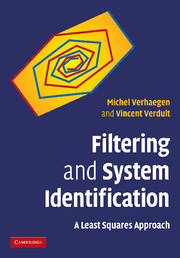Book contents
- Frontmatter
- Contents
- Preface
- Notation and symbols
- List of abbreviations
- 1 Introduction
- 2 Linear algebra
- 3 Discrete-time signals and systems
- 4 Random variables and signals
- 5 Kalman filtering
- 6 Estimation of spectra and frequency-response functions
- 7 Output-error parametric model estimation
- 8 Prediction-error parametric model estimation
- 9 Subspace model identification
- 10 The system-identification cycle
- References
- Index
3 - Discrete-time signals and systems
Published online by Cambridge University Press: 14 January 2010
- Frontmatter
- Contents
- Preface
- Notation and symbols
- List of abbreviations
- 1 Introduction
- 2 Linear algebra
- 3 Discrete-time signals and systems
- 4 Random variables and signals
- 5 Kalman filtering
- 6 Estimation of spectra and frequency-response functions
- 7 Output-error parametric model estimation
- 8 Prediction-error parametric model estimation
- 9 Subspace model identification
- 10 The system-identification cycle
- References
- Index
Summary
After studying this chapter you will be able to
define discrete-time and continuous-time signals;
measure the “size” of a discrete-time signal using norms;
use the z-transform to convert discrete-time signals to the complex z-plane;
use the discrete-time Fourier transform to convert discrete-time signals to the frequency domain;
describe the properties of the z-transform and the discrete-time Fourier transform;
define a discrete-time state-space system;
determine properties of discrete-time systems such as stability, controllability, observability, time invariance, and linearity;
approximate a nonlinear system in the neighborhood of a certain operating point by a linear time-invariant system;
check stability, controllability, and observability for linear time-invariant systems;
represent linear time-invariant systems in different ways; and
deal with interactions between linear time-invariant systems.
Introduction
This chapter deals with two important topics: signals and systems. A signal is basically a value that changes over time. For example, the outside temperature as a function of the time of the day is a signal. More specifically, this is a continuous-time signal; the signal value is defined at every time instant. If we are interested in measuring the outside temperature, we will seldom do this continuously. A more practical approach is to measure the temperature only at certain time instants, for example every minute. The signal that is obtained in that way is a sequence of numbers; its values correspond to certain time instants. Such an ordered sequence is called a discrete-time signal.
Information
- Type
- Chapter
- Information
- Filtering and System IdentificationA Least Squares Approach, pp. 42 - 86Publisher: Cambridge University PressPrint publication year: 2007
